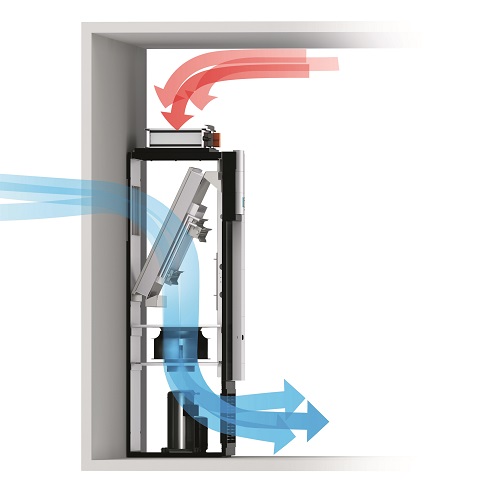With patient safety a priority, NHS staff need uninterrupted access to clinical data 24 hours per day, 365 days a year. Phil McEneaney, from STULZ UK, warns that a failure to understand the difference between comfort cooling and precision cooling, is resulting in poorly specified equipment – leading to higher costs, IT failures and increased risk.
Hospitals need to ensure constant uptime of its IT infrastructure. Investment in reliable cooling is a fundamental aspect of this requirement – server rooms that are subjected to high thermal loads need constant climatic conditions in order to work reliably.
Poorly specified cooling technology can result in erratic climate control; increased operating expenditure, and costly disruption to IT operations. In recent years, the government and national NHS leaders have set out a high-level vision and goals for digitising the NHS. From life-saving decision-making tools and patient monitoring technologies, to electronic patient records and tracking of medical devices, reliable IT has become the backbone of the NHS and is critical to the delivery of safe, efficient care. But are installers of cooling solutions prepared for these developments? A lack of awareness of the differences between comfort cooling and precision cooling is impacting the reliability of IT infrastructure, resulting in serious consequences for hospitals and the NHS.
Far too many hospitals and medical centres install comfort cooling in small server rooms instead of the correct precision cooling. This is a common mistake; there is a need for education on the importance of precision cooling in delivering resilient IT operations. We are frequently called in to replace inappropriate units installed in technical spaces.
Comfort cooling units are designed for cooling people in offices and retail environments. This type of cooling technology is intended to operate for short periods of time (of around five hours per day, five days per week) and the typical life expectancy for a unit is around five years. Precision cooling, on the other hand, is designed for use in technical environments, 24 hours per day, seven days per week, and the typical life span is much longer – usually between 10 and 15 years.
Temperature accuracy
Stulz UK’s precision air conditioning units ensure optimum temperature accuracy with maximum tolerances of +/- 1 °C and are designed to dissipate isolated thermal loads even from distant corners of the room. Comfort units, on the other hand, can normally deviate from the set value by as much as +/- 3 °C. This is significant as information and communication technology only works reliably and without faults within a relatively narrow temperature range. There are other important differences that also need to be understood, however.
Comfort cooling units as part of their design are designed to cater for ‘latent heat’. Environments that are populated by people (as opposed to technical equipment) produce this type of heat, which contains moisture, while technical spaces (such as server rooms) radiate pure heat – referred to in the industry as ‘sensible heat’. A comfort cooling unit will have a typical ‘sensible heating ratio’ of between 0.5 and 0.6, while a precision unit will have a sensible heat ratio of 1.
Comfort cooling units, which are designed to remove the moisture produced in hospital wards, offices and non-technical areas can use up to 50% of their energy for dehumidification. This is an important difference – precision air conditioning units convert more than 95% of the energy used exclusively into cooling capacity, producing energy efficiency and power saving opportunities. In fact, a precision cooling unit will use up to 50% less energy to run than a comfort unit of same capacity. Therefore, the technology required to achieve this pays off quickly in terms of lower operating costs. A comfort cooling unit rated at 10kW, with a sensible heat ratio of 0.5, will only deliver 5kW of sensible cooling. A precision cooling unit, with a heat ratio of 1, on the other hand, will deliver the full 10kW. This means you may need to specify two comfort cooling units to deliver the same capacity as one precision cooling unit.

Total cost of ownership
There are significant risks associated with inappropriate use of comfort cooling units, which installers need to be aware of. Unlike comfort air conditioning units, precision units feature strictly controlled and accurate dehumidification (tolerance +/- 5% relative humidity), as too much humidity can lead to condensation and corrosion, while too little can cause static charges, data loss and damage to hardware.
If you are removing moisture from the air, via a comfort system, you must be aware that the air will become drier and this can lead to static build-up in the technical space. These static shocks can be quite powerful and lead to failures of sensitive electronic equipment. We have seen instances where comfort cooling units have been specified, and the client has had to purchase additional equipment to add moisture to the room. Humidification units add an extra layer of cost to the original installation and are very expensive to run – which ultimately increases the total cost of ownership of comfort cooling solutions.
Other factors also contribute to increased expenditure and a replacement compressor may be needed after as little as three years, if the unit is run day in, day out, as comfort units are not designed for this level of continuous operation. Precision cooling units with EC fan technology can also offer further savings in running costs, however. The technology consumes up to 30% less energy than a conventional 3-phase fan; precision units (such as the MiniSpace EC range) can also run in energy-saving partial load mode and have a high motor efficiency of up to 92%. It is a “false economy” to prioritise capital outlay when specifying air-conditioning units: If you install a solution that isn’t appropriate for the technical environment, you will have issues. Effectiveness needs to be the primary consideration, along with the long-term operating costs.
Operating features: comfort vs precision
It is important to note that comfort cooling systems also perform ‘oil return cycles’, which override the set temperature controls and can lead to intermittent falls in temperature. While this is less of a problem in server rooms, this can present issues in environments such as laboratories, where precise temperatures are critical to the integrity of the testing processes. Precision cooling units do not need this operating feature and therefore do not present an operational risk in this way.
In addition, there is no ‘fall off’ in capacity on long pipe runs, which presents another advantage over comfort cooling systems. Pipe runs can affect the efficiency of the cooling system, so this is an important consideration when specifying a solution. Also, the water collected by comfort cooling units needs to be disposed of and pumped to a drain – this presents further challenges, as there is a potential risk of leaks or flooding in the server room, which could result in significant damage to electronic equipment.
Air filtration is another important factor when comparing comfort versus precision cooling. Precision air conditioning units (such as those manufactured by Stulz), filter and circulate three times the amount of air as comfort units with the same rated capacity.
Other differences are also important to note – for comfort cooling applications, it is less important for the filter to be highly effective in removing small particles; dust circulation has no detrimental effect in a non-technical environment. In server rooms and technical spaces, it is crucial to prevent particles being blown or sucked into technical equipment, as this can shorten the lifespan of IT assets.
Advanced precision cooling units can provide continuous monitoring and control of air filtration to ensure high availability. In the case of Stulz UK’s MiniSpace EC range, an alarm notification can be raised via mobile phone or through the building management system. This helps hospitals ensure the resilience and availability of their IT operations at all times.
Conclusion
Ultimately, rooms subjected to high thermal loads need constant climatic conditions in order to work reliably. Fluctuating temperatures, humidity and dust jeopardise both function and data stocks. Precision cooling technology is specifically designed for server rooms and technical environments where reliable thermal optimisation and high availability are crucial business imperatives.
With an increase in digitising the NHS predicted in the near future, it will become particularly important to understand the differences between ‘precision’ and ‘comfort’ when applying cooling for these systems. Many specifiers and installers fail to appreciate the impact of employing inappropriate cooling technology until it is too late; there is an urgent need for further education to avoid costly mistakes and to prevent the risks associated with poor climate control.





